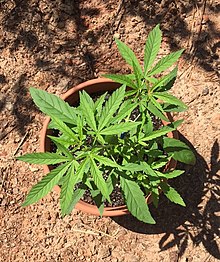Cannabis ruderalis
| Cannabis ruderalis | |
|---|---|
 |
|
| Scientific classification | |
| Kingdom: | Plantae |
| (unranked): | Angiosperms |
| (unranked): | Eudicots |
| (unranked): | Rosids |
| Order: | Rosales |
| Family: | Cannabaceae |
| Genus: | Cannabis |
| Species: | C. ruderalis |
| Binomial name | |
|
Cannabis ruderalis |
|
Cannabis ruderalis is a species of Cannabis originating in central Russia. It is less common than the other species of Cannabis.
The term ruderalis is derived from the Latin rūdera, which is the plural form of rūdus, a Latin word meaning rubble, lump, or rough piece of bronze. A ruderal species refers to any plant that is the first to colonize land after a disturbance removing competition.
Cannabis ruderalis rarely grows over two feet in height, and matures in approximately seven weeks. The plants have a "thin, slightly fibrous stem" with little branching. Foliage is open with large leaves.
Cannabis ruderalis will produce flowers based on its age, rather than light cycle, unlike flowering in C. sativa and C. indica varieties. This kind of flowering is also known as "autoflowering".
It has less THC in its resin compared to other Cannabis species. However, it is often high in cannabidiol (CBD).
Cannabis ruderalis was first scientifically identified in 1942 in southern Siberia, although it also grows wild in other areas of Russia. The Russian botanist, Janischewski, was studying wild Cannabis in the Volga River system and realized he had come upon a third species.C. ruderalis is a hardier variety grown in the northern Himalayas and southern states of the former Soviet Union, characterized by a more sparse, "weedy" growth.
Similar C. ruderalis populations can be found in most of the areas where hemp cultivation was once prevalent. The most notable region in North America is the midwestern United States, though populations occur sporadically throughout the United States and Canada. Large wild C. ruderalis populations are also found in central and eastern Europe, most of them in Lithuania, Belarus, Latvia, Estonia and adjacent countries. Without human selection, these plants have lost many of the traits they were originally selected for, and have acclimated to their environment.
...
Wikipedia
